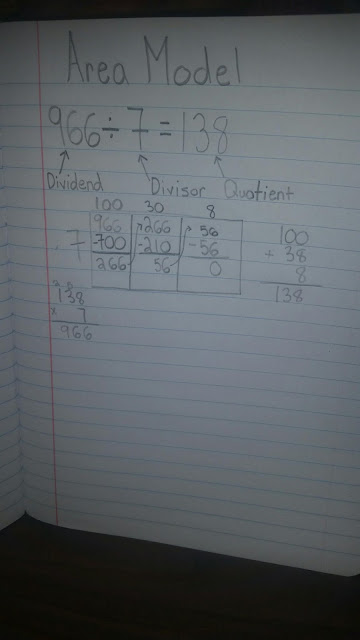Another way to divide large numbers is by using partial quotients.
This means that you look at one or two digits at a time.
Friday, October 30, 2015
Friday, October 23, 2015
Area Model Division
The steps to doing area model are:
(I recommend looking at the picture while reading.... It sounds so complicated but it's really quite simple!)
Make a rectangle. Put your divisor on the side and your dividend in the box.
Find out how many hundreds you can fit inside.
I always cover up the digits so we're just looking at the first one or two.
In this case, I'm asking, "How many times can 3 fit into 14?
The answer is 4.
That means my first partial quotient is 4.
Now I multiply 400x3 to get 1,200.
I subtract 1,422-1,200 to get my next part of the problem.
I bring that over and then I start the process again.
How many times can 3 go into 22?
7.
That means my next partial quotients is 70.
70x3 = 210
222-210=12
Now I start again with 12.
3 goes into 12 four times.
My last partial quotient is 4.
I subtract it and get 0.
Now I add up all my partial quotients to get my final answer.
I multiply my quotient times my divisor to check my answer. I should get my dividend.
(I recommend looking at the picture while reading.... It sounds so complicated but it's really quite simple!)
Make a rectangle. Put your divisor on the side and your dividend in the box.
Find out how many hundreds you can fit inside.
I always cover up the digits so we're just looking at the first one or two.
In this case, I'm asking, "How many times can 3 fit into 14?
The answer is 4.
That means my first partial quotient is 4.
Now I multiply 400x3 to get 1,200.
I subtract 1,422-1,200 to get my next part of the problem.
I bring that over and then I start the process again.
How many times can 3 go into 22?
7.
That means my next partial quotients is 70.
70x3 = 210
222-210=12
Now I start again with 12.
3 goes into 12 four times.
My last partial quotient is 4.
I subtract it and get 0.
Now I add up all my partial quotients to get my final answer.
I multiply my quotient times my divisor to check my answer. I should get my dividend.
Tuesday, October 20, 2015
Sunday, October 18, 2015
Division
Here are the division TEKS:
4.4F use strategies and algorithms, including the standard algorithm, to divide up to a four-digit dividend by a one-digit divisor; Ⓢ :
4.4H solve with fluency one- and two-step problems involving multiplication and division, including interpreting remainders. Ⓡ
The main vocabulary words for division are:
Dividend- Number being divided
Divisor- Number doing the dividing
Quotient- Answer to division problem
The first way we learn about division is to use partial quotients. It's very similar to partial products.
Here's a little slideshow that walks you through the steps.
I created my own freebie on teachers pay teachers too.
Here's my division KAHOOT!
Tuesday, October 13, 2015
Two Digit by Two Digit STANDARD ALGORITHM
Time to learn the standard way to multiply two digit by two digit numbers!
Our multiplication anchor chart.
Showing how to do BOTH methods.
Math games!
Small group with our intern teacher!
Bow tie reminder.
Math journals.
Wednesday, October 7, 2015
Area Models Two Digit Multiplication
It's so important to teach our students different strategies for multiplication.
One strategy for two digit by two digit multiplication is called AREA MODEL.
This means that we decompose the numbers into their expanded form, and then multiply each part.
I created a Kahoot game on two digit by two digit multiplication here:
https://play.kahoot.it/#/k/31b883a4-5ac2-40cf-a5a5-2417d2e4704c
For example 23 x 17 becomes 20+3 and 10+7
Then as you can see below
Then I add up all my partial products to get my final product. 200+140+30+21=391
Here's an example I did on our interactive whiteboard.
Here's one I found online.
Another example.
Subscribe to:
Comments (Atom)


































